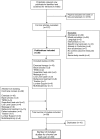A systematic review on the effectiveness of physical and rehabilitation interventions for chronic non-specific low back pain
- PMID: 20640863
- PMCID: PMC3036018
- DOI: 10.1007/s00586-010-1518-3
A systematic review on the effectiveness of physical and rehabilitation interventions for chronic non-specific low back pain
Abstract
Low back pain (LBP) is a common and disabling disorder in western society. The management of LBP comprises a range of different intervention strategies including surgery, drug therapy, and non-medical interventions. The objective of the present study is to determine the effectiveness of physical and rehabilitation interventions (i.e. exercise therapy, back school, transcutaneous electrical nerve stimulation (TENS), low level laser therapy, education, massage, behavioural treatment, traction, multidisciplinary treatment, lumbar supports, and heat/cold therapy) for chronic LBP. The primary search was conducted in MEDLINE, EMBASE, CINAHL, CENTRAL, and PEDro up to 22 December 2008. Existing Cochrane reviews for the individual interventions were screened for studies fulfilling the inclusion criteria. The search strategy outlined by the Cochrane Back Review Groups (CBRG) was followed. The following were included for selection criteria: (1) randomized controlled trials, (2) adult (≥ 18 years) population with chronic (≥ 12 weeks) non-specific LBP, and (3) evaluation of at least one of the main clinically relevant outcome measures (pain, functional status, perceived recovery, or return to work). Two reviewers independently selected studies and extracted data on study characteristics, risk of bias, and outcomes at short, intermediate, and long-term follow-up. The GRADE approach was used to determine the quality of evidence. In total 83 randomized controlled trials met the inclusion criteria: exercise therapy (n = 37), back school (n = 5), TENS (n = 6), low level laser therapy (n = 3), behavioural treatment (n = 21), patient education (n = 1), traction (n = 1), and multidisciplinary treatment (n = 6). Compared to usual care, exercise therapy improved post-treatment pain intensity and disability, and long-term function. Behavioural treatment was found to be effective in reducing pain intensity at short-term follow-up compared to no treatment/waiting list controls. Finally, multidisciplinary treatment was found to reduce pain intensity and disability at short-term follow-up compared to no treatment/waiting list controls. Overall, the level of evidence was low. Evidence from randomized controlled trials demonstrates that there is low quality evidence for the effectiveness of exercise therapy compared to usual care, there is low evidence for the effectiveness of behavioural therapy compared to no treatment and there is moderate evidence for the effectiveness of a multidisciplinary treatment compared to no treatment and other active treatments at reducing pain at short-term in the treatment of chronic low back pain. Based on the heterogeneity of the populations, interventions, and comparison groups, we conclude that there are insufficient data to draw firm conclusion on the clinical effect of back schools, low-level laser therapy, patient education, massage, traction, superficial heat/cold, and lumbar supports for chronic LBP.
Figures
References
-
- Abenhaim L, Rossignol M, Valat JP, Nordin M, Avouac B, Blotman F, Charlot J, Dreiser RL, Legrand E, Rozenberg S, Vautravers P. The role of activity in the therapeutic management of back pain. Report of the International Paris Task Force on Back Pain. Spine. 2000;25:1S–33S. doi: 10.1097/00007632-200002151-00001. - DOI - PubMed
-
- Heymans MW, van Tulder MW, Esmail R, Bombardier C, Koes BW (2004) Back schools for non-specific low-back pain. Cochrane Database Syst Rev:CD000261 - PubMed
-
- Khadilkar A, Milne S, Brosseau L, Robinson V, Saginur M, Shea B, Tugwell P, Wells G (2005) Transcutaneous electrical nerve stimulation (TENS) for chronic low-back pain. Cochrane Database Syst Rev:CD003008 - PubMed
Publication types
MeSH terms
LinkOut - more resources
Full Text Sources
Medical
Miscellaneous


